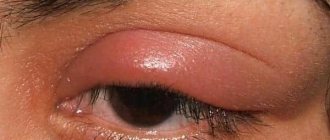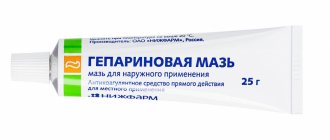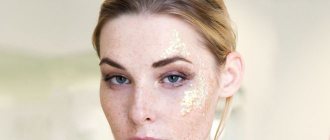How to remove swelling from the eyelids?
Swelling occurs due to the accumulation of a large volume of fluid in the intercellular space. The skin around the eyes is the thinnest.
In this article
- How to remove swelling from the eyelids?
- The most common causes of eyelid swelling
- How to relieve swelling of the eyelids after drinking alcohol?
- Eyelids are swollen after tattooing - what to do?
- How to remove swelling from the upper eyelid using folk remedies?
- How does massage help remove swelling from the upper eyelids?
- How else can you remove swelling from your eyelids?
Because of this, swelling appears on the eyelids or under the eye sockets. Other parts of the body also swell, but on the face it becomes immediately noticeable. Swelling of the eyelid or eye is not only a cosmetic problem. This symptom may signal the development of a disease, not necessarily related to the organs of vision. Let's look at all the possible causes of eyelid swelling and find out how to remove them.
Characteristics of acquired ptosis
The manifestation of the disease is often directly related to age-related changes in the body. In this case, the process proceeds unevenly, first one fold falls, then the second, and asymmetry may remain. Treatment of this type of disease is carried out exclusively by surgery. It is advisable to seek help at the initial stage. If complications arise from the excessive use of botulinum toxin drugs or the technology of its administration is violated, the muscles do not ensure the outflow of lymph, which provokes its accumulation, leading to large-scale edema.
The problem may arise due to individual intolerance to the drug and the unprofessionalism of the cosmetologist. In this case, it is necessary not only to correct the consequences, but also to select high-quality care products that will help speed up regeneration and stop age-related changes. A specialist will tell you how to get rid of ptosis of the face and upper eyelid after a full examination and tests. You should not rely on chance, since with advanced pathology, vision is impaired and strabismus occurs.
What causes swelling of the eyelids and what should be done to relieve it?
Swelling may occur in one eye or both. In such cases, they speak of unilateral or bilateral edema, respectively. Most often the upper eyelids swell. This can happen for various reasons - pathological and non-pathological. The first group of factors includes eye diseases and diseases of other organs. Swelling of the eyelids is almost always observed with the development of inflammatory ophthalmopathologies. Among them:
- keratitis;
- blepharitis;
- conjunctivitis;
- iridocyclitis;
- barley.
The eyelids also swell with some systemic ailments - diseases of the kidneys, liver, blood vessels, diabetes mellitus, allergies, abdominal dropsy. Swelling of the upper eyelid is a very common symptom that cannot be called specific. It is difficult to determine from this sign alone whether it is a consequence of any pathology. However, often the eyelids swell for reasons that are not related to disease.
Diagnostics
Important! If you have swelling of the upper eyelid, you should visit an ophthalmologist, who will prescribe examinations to identify possible diseases that contribute to the development of this condition.
The list of diagnostic procedures includes:
- biochemical and general blood test;
- Analysis of urine;
- electrocardiogram;
- Ultrasound of the abdominal organs (to identify pathologies of the urinary system);
- X-ray of the spine and skull.
If there is no reason to assume that the cause of the swelling lies in ophthalmological diseases, based on the results of the examination, a diagnosis is prescribed by other specialists, depending on the expected diagnosis.
The most common causes of eyelid swelling
Swelling of the eyelids appears due to hormonal imbalances, as a result of visual fatigue, injury, after an insect bite, due to prolonged exposure to ultraviolet radiation on the eyes and skin.
In some cases, swelling occurs briefly after taking certain medications. However, the most common causes of edema are:
- alcohol consumption;
- poor nutrition;
- tattoo;
- overwork.
Let's look at these reasons in more detail and list ways that help quickly remove swelling.
How to relieve swelling of the eyelids after drinking alcohol?
After drinking alcohol-containing drinks in large quantities, not only the eyelids, but also the entire face swells. With chronic alcoholism, swelling occurs in the legs and arms, which already indicates the development of severe pathologies of internal organs. The main cause of edema is the inability of the liver to process ethyl alcohol into components that would be harmless to the body. Also, swelling may indicate poor functioning of the urinary system, which leads to fluid stagnation.
Swelling usually goes away within a day or 24 hours. The speed of recovery depends on several factors:
- amount of alcohol consumed;
- frequency of drinking alcoholic beverages;
- person's age;
- condition of internal organs;
- genetic characteristics;
- body weight.
Edema can also occur in people who rarely drink. It depends on the body. Sometimes a feast cannot be avoided. Many people drink alcohol at corporate events and then have to go to work the next day. In the morning you saw that your face and eyelids were swollen, and you somehow needed to leave the house. What to do in this case? Women who are more concerned about this problem than men can hide puffiness under makeup. In principle, swelling will go away on its own within one or two days. It is only necessary to restore the balance of salts and fluids in the body, as well as get enough sleep.
Prevention
If we talk about non-pathological swelling under the eyes, you can avoid them or reduce the likelihood of their development as follows:
- follow the rules for wearing and storing contact lenses and promptly replace such products upon expiration;
- do not eat salty, spicy, fried foods before bed and drink less liquid;
- in the autumn-spring period, to strengthen the immune system, take vitamin complexes ;
- monitor the body's reaction to various potential allergens and exclude contact with them.
You should also be careful about your eye health and observe good personal hygiene.
Note! If you notice the first signs of ophthalmic diseases, you should immediately undergo examination by a specialist.
And people aged 35-40 years old need to undergo such checks regularly (at least once a year), since some pathological processes can go unnoticed in the initial stages.
Eyelids swell in the morning - what is the reason and how to remove the swelling?
If your eyelids are swollen after sleep, most likely the reason for this is poor nutrition. A late dinner consisting of smoked or too salty foods makes you thirsty.
A person drinks one or two extra glasses of water before bed, and wakes up in the morning with a swollen face. Usually there are bags or bruises under the eyes. Some people experience swelling of the upper eyelids. Also causes of swelling can be:
- lack of sleep;
- cosmetics that are not washed off before bed;
- smoking;
- overwork;
- stress;
- cry.
All these factors are not associated with diseases, so you can eliminate swelling yourself at home. You can quickly relieve swelling caused by the above reasons using cosmetic procedures, massage, ice and other means, which we will discuss later.
Eyelids are swollen after tattooing - what to do?
Tattooing is a cosmetic procedure that is very popular today. It is performed in beauty salons only by qualified specialists. Usually, materials that are safe for health are used, so tattooing does not cause side effects. However, no one is safe from them either.
The causes of eyelid swelling after tattooing can be:
- failure to comply with the cosmetologist’s instructions after the procedure;
- use of low quality pigment;
- too dry or thin skin;
- allergic reaction to dye;
- infection under the skin.
Eyelid or eyebrow tattooing is performed using a cosmetic instrument that comes into contact with the skin. Dye is injected underneath it. In this case, the integrity of the skin is compromised. As already noted, facial skin is very thin and sensitive. Any irritating factor can cause swelling under the eyes or on the eyelids. There is a risk of developing an inflammatory process, which is, of course, rare if the procedure is performed in a good salon.
Tissues react to the pigment as if it were a foreign body. Slight swelling is normal after insertion. Also, some patients complain of pain, itching, redness of the eyelids or eyebrows. However, there should not be severe swelling. Temporary swelling subsides during the first 24 hours after the procedure. If this does not happen, you need to consult a doctor.
How to remove swelling in such cases? It is not recommended to eliminate the symptom yourself until a specialist determines the cause of its occurrence.
Classification and stages of development
Like other pathologies, this one has its own characteristic features that make it possible to divide the total mass according to its external manifestation and prerequisites for its occurrence.
Neurological
It is also called neurogenic, since the root causes are disruptions in the central nervous system. In the vast majority of cases, the violation is observed on one side. If there is no clear functioning of the frontal and ocular muscles, then pathology occurs. These are the main causes of ptosis of the upper eyelid in adults. In this case, the bilateral appearance indicates a previous heart attack, and when the oculomotor nerve is damaged, pupil dilation is observed, and eye mobility is impaired. All cases are purely individual; the problem may spontaneously disappear when the affected area is stabilized. If treatment is necessary, the method is selected individually.
Myogenic blepharoptosis
Develops with myasthenia gravis, ocular myopathy, as a result of local or systemic muscle damage. There is also a toxic form associated with poisoning from lead or other heavy metals or their salts. Impairment of the motor function of the eye is possible, often accompanied by a decrease in the tone of the facial muscle tissue. How to correct ptosis of the upper eyelid in this case will become clear after a thorough detailed examination.
Mechanical view
Occurs if muscle function is hampered by scar formation, wearing lenses, or due to a tumor or injury. Sometimes only supportive procedures are required to stimulate natural regeneration. If the damage is very severe, then surgery is recommended.
Aponeurotic
This type is also called senile, when a person experiences stretching of muscles and ligaments and their weakening. In other cases, postoperative complications, cataract removal, severe infections, and injuries can trigger the disorder. Development occurs on both sides, but one is more affected. The congenital form is rare and occurs equally in men and women. Patients note a gradually progressive drooping of skin folds. To remove ptosis of the upper eyelid, surgical correction is indicated in most cases; the prognosis is favorable.
Pseudoptosis
In fact, this is a purely cosmetic problem. It is characterized by excess skin, which creates a severe fold that interferes with normal vision. Often it occurs in combination with age-related changes. To promptly refuse unnecessary or incorrect surgery, a comprehensive diagnosis is important. Treatment depends on the cause of the abnormality.
Traumatic blepharoptosis
When determining this type of disorder, experts recommend waiting 6 months before performing correction, since cases of spontaneous resolution of the situation are not uncommon. The etiology includes many factors and is diagnosed after the swelling has resolved. During the healing process, scarring and lagophthalmos are possible. If after time the condition does not improve, then muscle resection is performed. This is the best option to cure ptosis of the upper eyelid.
How to remove swelling of the eyelids?
Swelling from the eyelid can be eliminated at home, in a clinic or in a salon. It all depends on what is causing the symptom, whether you have the time and money or not. If the nature of the swelling is pathological, then you first need to see a doctor. Typically, swelling of the eyelids as a symptom of the development of an eye disease is accompanied by the following signs:
- hyperemia or pallor;
- transillumination of blood vessels;
- lacrimation;
- itching and burning;
- thickening of the cartilage of the eyelid;
- pain;
- discharge of mucus or pus.
If you have several of these symptoms, you should see an ophthalmologist. It is dangerous to relieve swelling from the eyelid using folk remedies or medicines that are in your home medicine cabinet. The disease may become more complicated. If you are sure that swelling of the eyelid is not a consequence of the development of the disease, you can use the recipes of the so-called traditional medicine. Let's find out what you can urgently do to get rid of puffiness.
How to remove swelling from the upper eyelid using folk remedies?
You can quickly get rid of swelling of the eyelids with the help of lotions, compresses and face masks. They do not cure diseases, but help soothe the skin and muscles, which promotes the outflow of excess fluid. On the Internet you can find many recipes that are used to relieve swelling of the eyelids. Let's list some of them:
- Cold. Everyone has ice cubes in their refrigerator. They need to be wrapped in gauze or bandage and applied to closed eyelids for 1-2 minutes. The eyes should not be too cold. It is better to apply ice to the eyelids intermittently.
- Carrot. Make a mask from the grated vegetable. You can apply it not only to the upper eyelids, but also to the skin under the eyes, the bridge of the nose, and cheekbones.
- Flax seeds. They need to be filled with hot water and left overnight. The resulting broth is filtered. Lotions are made from it and applied to the eyelids for 10-15 minutes. This remedy is believed to help with swelling and inflammation. However, if there is an inflammatory process, it should be treated by a doctor.
- Tea with mint. Tea may have a decongestant effect. Tea compresses are applied to the eyes for 15-20 minutes. Instead of tea leaves, you can also use plants such as chamomile, calendula, thyme, fireweed, and sage.
- Chilled milk. Tampons are moistened in it and left on the upper eyelids for 20-25 minutes. Also, some supporters of traditional medicine suggest using other dairy products - cottage cheese or sour cream.
- Raw potatoes. It can be cut into circles or grated on a fine grater to make compresses.
- Egg white. It has an astringent effect. Apply to eyelids for 15-20 minutes, then wash off with warm water. Daily use of eggs in this way helps smooth out wrinkles on the eyelids.
These products help to slightly eliminate swelling. There are more effective methods. Let's find out how to remove swelling from the upper eyelids using massage.
Why can the eyelid of only one eye swell?
Most ophthalmological pathologies (especially those caused by pathogenic microorganisms) are bilateral - both organs of vision are affected at once.
But swelling of the upper eyelid can sometimes appear only in the left or right eye. often occurs due to colds of infectious origin .
It is worth noting! This is also a characteristic sign of allergic dermatitis, which occurs when an allergen comes into direct contact with the skin.
Typically, swelling of one eye that occurs in the upper eyelid spreads further along the face, but it may not spread to the other half of the face.
The most common cause of unilateral swelling is injury or insect bites - that is, local damage that does not spread further along the surface.
Such swelling is always short-lived and, with first aid and symptomatic therapy, disappears within a few days.
How does massage help remove swelling from the upper eyelids?
If your upper eyelids are swollen after sleep or due to alcohol consumption, you can do a lymphatic drainage massage.
Similar services are provided in salons. The massage is performed with hands or a special device. Massaging the eyelids helps improve blood circulation and fluid outflow. After just one session, which lasts 15-20 minutes, the swelling noticeably subsides. Not everyone has the opportunity to visit expensive salons. If you urgently need a massage to quickly relieve swelling from the upper eyelids, perform it according to the following algorithm:
- wash your hands and face with soap;
- apply moisturizer or oil to the skin;
- Using your middle and index fingers, massage your upper eyelids in a circular motion from the outer corner of your eyes to the inner corner;
- apply a few light pressures to the eyeballs and pat the skin around them with your hands;
- Massage your eyelids, temples, and eyebrows in a circular motion.
The massage should be completed with a contrast wash. If you do it daily, swelling will rarely appear. However, it is necessary to consult a doctor before performing this procedure, as there are contraindications to it:
- eye injuries;
- postoperative period;
- chronic ophthalmopathologies;
- inflammatory diseases of the eyelids and eyes;
- cataract;
- glaucoma;
- retinal detachment.
Do not forget that swelling of the eyelids as a symptom of any illness can only be treated under the guidance of a doctor, so as not to aggravate the situation. You can resort to folk remedies and massage only if it is approved by a specialist, and swelling rarely occurs and is not due to disease.
How to treat ptosis of the upper eyelid
There are several methods that are used depending on the causes of the disorder, the degree of its development and the individual characteristics of the human body. When congenital pathology is detected in the early stages, if vision is not impaired, comprehensive prevention is sufficient. If the problem is caused by Botox injections, then experts recommend waiting until the effect of the botulinum toxin wears off. In any case, the treatment regimen is developed individually.
Conservative treatment
Physiotherapeutic procedures are quite effective in eliminating blepharoptosis:
- massage;
- electrophoresis;
- UHF;
- microcurrent therapy.
The complex contains vitamin B and neuroprotectors. Gymnastics for the eyes is effective if the eyelids droop on their own due to aging of the body. A well-chosen program will help tighten muscles and restore them to their former tone.
Cosmeceuticals
With slight sagging tissue, you can completely get by with cosmetics. But they must be highly effective, not cause allergies, and have a tightening effect. Innovative original injection preparations, creams and serums made in Japanese and Korean from the RHANA Corporation, containing unique biologically active substances, allow you to stop the processes of premature aging, tighten and strengthen tissues, restore elasticity to the epidermis and lift the eyelid in a natural way.
- Patches for lifting and moisturizing with kinetin.
- Anti-aging lifting cream for the eye area “24 hours”.
Surgical method
Surgery is prescribed only in advanced stages, if the quality of vision is impaired or the consequences of injury interfere with normal work. To achieve the effect, the muscle is cut or shortened slightly. Rehabilitation lasts 3-4 weeks, under the supervision of a surgeon. The method allows you to completely get rid of pathology for life.
Types of postoperative complications
The most common is an allergy to local anesthetics. Swelling or the effect of incomplete closure of the eyelids may appear. Bleeding and infections are rare. Since the procedure is performed under local anesthesia. There are no serious consequences from anesthesia either. Sometimes keratitis is diagnosed, then the use of artificial tears and special gels is recommended.
Prevention
There are no targeted actions; indirect actions include regular examinations with an ophthalmologist, the use of cosmetic care products with a lifting effect for the eyelids and skin around the eyes, self-massage and maintaining the general tone of the body.
Will eye exercises help remove swelling?
Special exercises to relax the eye muscles will help relieve swelling if it is not caused by illness. Eye exercises increase blood circulation and oxygen supply to tissues. This also helps eliminate swelling, although not as effective as lymphatic drainage massage. If desired, you can use several treatment methods at the same time.
Try the following exercises:
- move your eyeballs in different directions;
- close your eyes tightly and open your eyes wide, repeating this algorithm 5 times;
- massage the upper eyelids with your fingers from the bridge of the nose to the outer corner of the eyes and back;
- pull the lower eyelid up and relax, then repeat this with the second eyelid.
You can use other sets of exercises. It is better for your doctor to choose it for you, especially if you have vision problems. Gymnastics may be contraindicated in case of refractive errors, for which special exercises are selected. You should also not do exercises if you have inflammatory eye diseases, retinal pathologies, increased intraocular pressure and some other diseases.
How else can you remove swelling from your eyelids?
For swelling, physiotherapeutic procedures may be prescribed. Some of them are available only in paid clinics. This method of treatment is the most effective of those listed. In several sessions of physiotherapy, it is possible not only to relieve swelling, but also to smooth out wrinkles, increase skin and muscle tone, and improve blood circulation in the eye area. The following procedures are applied:
- myostimulation;
- electrical stimulation;
- fractional thermolysis;
- cryotherapy.
There are contraindications to this treatment, so you will have to undergo an examination before the procedures.
Eye allergies: causes, symptoms, ways to combat swelling
Allergies often occur in different parts of the body, including the eyes: this is a unique disease, which is characterized by the manifestation of many symptoms at once. Such a complex process cannot but cause discomfort, especially considering that not everyone knows how to alleviate allergies and for what reason they occur in a particular person.
If you haven’t taken an allergen test and still have irritation under your eyes, it’s most likely due to a prohibited product or cosmetic ingredient. But how to recognize an allergy, understand why it appeared, and get rid of it? Let's tell you about everything in more detail.
Why do allergies occur around the eyes?
Despite the fact that literally anything can be an allergen, swelling of the eyelid is primarily caused by what is in the air. As soon as a microscopic particle of something that irritates your body gets on the mucous membrane, it will provoke an exacerbation.
Such irritants include:
- household dust;
- cold air;
- mold;
- ultra-violet rays;
- chemicals that were previously sprayed into the air;
- pollen;
- pet hair.
If you definitely haven’t eaten anything forbidden, but your eyes itch and hurt, make sure that none of the above can provoke a similar reaction in you.
In addition, there are other significant reasons for allergies.
SIGN UP FOR A CONSULTATION +7 (#{XXX}) #{XXX}-#{XX}-#{XX}
Problems with contact lenses
Sometimes people can wear lenses for years and not feel any discomfort, but one day they discover that their eyelids hurt and their eyes become itchy. The problem most likely lies in the fact that the solution for storing lenses has deteriorated or contains some component that is not suitable for you.
Also, if you wear makeup and style your hair and have your lenses in, a couple of splashes could get on them and cause irritation.
Inappropriate cosmetics
If you do not use hypoallergenic cosmetics, then any chemical reagent in your favorite eye shadow or mascara can cause a rash on the eyelids, blisters under the eyes, or redness. Red eyes are the most common symptom in this case, but then you need to make sure that you apply the makeup carefully enough and that a crumb of shadow simply does not get on the eyeball.
Treatment with eye drops
Not all medications are suitable for us: sometimes drops cause swelling of the eyes because they contain too powerful components. It is likely that you need something more gentle, so as soon as you notice that your eyes are swollen, call your doctor and ask for a different medicine.
SIGN UP FOR A CONSULTATION +7 (#{XXX}) #{XXX}-#{XX}-#{XX}
Main allergy symptoms
Eye allergies can present with a variety of symptoms: it all depends on whether the patient suffers from a chronic disease or is experiencing an acute form of the disease. The more severe the stage, the more signs of allergy can be noticed at the same time. True, there are exceptions - for example, some patients only have swollen eyeballs and a fever.
Among the characteristic symptoms are the following:
- swelling of the eyes, pronounced swelling;
- redness;
- the appearance of a foreign body sensation in the eyes;
- itching in the eyes and nose;
- lacrimation;
- fear of bright light, inability to stay in the sun for a long time;
- blurred vision;
- purulent or clear discharge.
Of course, there are other symptoms of an allergic reaction - some of them look like signs of a common cold, and therefore the patient does not immediately recognize what the problem is.
If your eyes itch, is this really a sign of an allergy?
It’s not at all necessary - for example, any child who constantly reaches somewhere with his hands will have itchy eyes quite often. In this case, you need to monitor his hygiene and visit a specialist from time to time to make sure that everything is in order with his eyes.
If an adult’s eye itches and you don’t overstrain your eyesight at the computer, then you really should be wary. The sooner you make an appointment with a doctor and understand what the problems are, the better it will be - treating eye diseases when they are advanced is not easy.
SIGN UP FOR A CONSULTATION +7 (#{XXX}) #{XXX}-#{XX}-#{XX}
Why are edema dangerous?
One of the most obvious signs of an allergy is swelling of the mucous membrane of the eye. It appears because more fluid accumulates in the skin of the eyelids under the influence of an irritant, and significantly weakens the protection of the visual organs.
Why? It's simple: due to edema, the lacrimal glands do not work as usual, and over time this leads to either increased dryness of the mucous membrane or excessive lacrimation. In addition, if swelling is started, it will entail pathological changes that can trigger another inflammatory process.
How to diagnose allergies
If you are not sure whether your eyelid irritation is normal or an allergic reaction, the best way out is to go for a diagnosis. A specialist will examine you and send you for tests to make an accurate diagnosis.
What you need to submit:
- blood test (general, but if necessary, biochemical);
- general urine analysis;
- bacteriological and cytological studies of the mucous membrane of the eye;
- skin test analysis.
SIGN UP FOR A CONSULTATION +7 (#{XXX}) #{XXX}-#{XX}-#{XX}
When a patient is eventually diagnosed with an allergy, he needs to make an appointment with an allergist: he will select the appropriate ointment, cream or drops that will alleviate the disease and help get rid of its symptoms. Under no circumstances should you prescribe treatment for yourself: this will only make things worse.
What can I do to make my allergies go away?
First of all, of course, you need to find out what exactly is causing your illness and eliminate any contact with the allergen. However, this is not enough, especially if the eyelids are already swollen and the quality of vision has significantly decreased.
A specialist usually prescribes medication:
- anti-inflammatory drugs;
- antibacterial drugs;
- antihistamines.
Many drops and tablets are highly effective and will help quickly relieve allergic edema, but you should not prescribe them to yourself without the participation of a doctor. Only a competent specialist will help you determine what suits you best and will not harm other elements of the body.
What happens if swelling is not treated?
Some people's eyelids always seem swollen, which is due to their structure or some congenital defect. In most cases, swelling goes away on its own without treatment. If swelling on the face is a frequent symptom that worries you, you need to make an appointment with an ophthalmologist. Pathological edema can, if left untreated, lead to the development of complications, including glaucoma. Also, constant swelling of the eyelids, if they block the pupil, can affect vision.
Prevention of edema includes the following rules:
- balanced diet, consumption of a small amount of salt and volume of water corresponding to body weight;
- rejection of bad habits;
- normal mode of work, rest and sleep;
- timely treatment of all diseases.
Swelling of the eyelids seems to be a harmless symptom, but if it occurs, it is better not to take risks and not to self-medicate, but to visit a doctor.
Diseases in which symptoms may be observed
Swelling of the upper eyelid is considered pathological when such a disorder is caused by some disease. Among these ailments, the most common are:
- Blepharoconjunctivitis . A disease that combines conjunctivitis (inflammation of the eye lining) and blepharitis (inflammation of the edge of the eyelid).
- Hemophthalmos. Hemorrhage into the vitreous body, which occurs most often as a result of other eye diseases. This is a fairly rare disorder that affects blood vessels, including the part of the circulatory system located in the upper eyelid.
- Conjunctivitis. The most common infectious or non-infectious lesion of the mucous eyes among all age groups. In such cases, the eyelids swell and take on a pronounced red color. Additional symptoms depend on the type of disease (allergic, bacterial, viral and others).
- Trachoma. An infectious chronic disease caused by chlamydia. Often in the early stages of development, the symptoms of the disease are mild or completely absent, and swelling of the eyelids appears last.
- Tuberculosis of the eye . An infectious disease caused by the tuberculosis bacillus. This pathology rarely develops independently and is mainly a complication of pulmonary tuberculosis.
- Endophthalmitis. An inflammatory disease that spreads to the internal structures of the organs of vision. As a result, purulent discharge accumulates in the tissues of the eyes and in the glands located in the eyelids. With endophthalmitis, the patient's vision is significantly impaired, swelling appears well, and the eyelids thicken and acquire a pronounced red tint.











